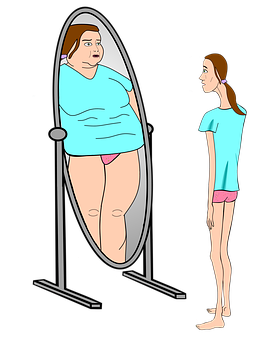 28 million. That’s the number of Americans Marla Ahlgrimm says has experienced an eating disorder at some point. The vast majority of those who have an unhealthy relationship with food are women.
28 million. That’s the number of Americans Marla Ahlgrimm says has experienced an eating disorder at some point. The vast majority of those who have an unhealthy relationship with food are women.
According to Marla Ahlgrimm there are many different types of eating disorders, but the most common are anorexia, bulimia, binge eating disorder, pica, rumination disorder, and food avoidant/restrictive food intake disorder.
Anorexia
Perhaps the most well-known of the eating disorders, anorexia is typified by highly restricted eating patterns. Marla Ahlgrimm says that women (and even men) with anorexia are fearful of gaining even small amounts of weight. They are typically several pounds underweight and go to extreme lengths to maintain what they perceive to be the perfect body type.
Bulimia
Marla Ahlgrimm describes bulimia as a cycle of binge eating and purging food. In other words, a person will eat large quantities of foods they tend to avoid and then induce vomiting to rid themselves of the “guilty” calories. People with bulimia may also take diuretics, laxatives, or enemas to rid their body of excess material.
Binge eating disorder
Binge eating disorder is different from bulimia in that people who binge eat with this mental health condition do not purge. Instead, Marla Ahlgrimm says they typically slip into a type of depression where they feel disgusted, ashamed, or guilty about their indulgence.
Pica
Unlike the three eating disorders previously mentioned, pica is typically not associated with any type of body dysmorphia or attempt to fit into a societal mold of the ideal physique. Instead, Marla Ahlgrimm describes pica as a potentially serious mental health condition that tells the sufferer’s brain to crave things like soap, hair, rocks, metal, or cornstarch. A person with pica will consume these non-food items and is at a significant risk of poisoning and severe gastrointestinal disturbances.
Rumination disorder
A newly recognized eating disorder, Marla Ahlgrimm explains that rumination occurs when a person routinely regurgitates, re-chews, and re-swallows previously consumed food. This disorder can take hold during infancy and, in severe cases, may be fatal as it triggers malnutrition.
Avoidant/restrictive food intake disorder
Avoidant/restrictive food intake disorder (previously known as feeding disorder) is another mental health condition that changes a person’s eating habits. People with this condition avoid or severely restrict some or all foods based on anything from temperature to smell. This can result in nutritional deficiencies that Marla Ahlgrimm notes may need to be compensated for with dietary supplements or a feeding tube.
Other types of eating disorder
 While the eating disorders listed above are by far the most common, there are at least three other named eating disorders. These include:
While the eating disorders listed above are by far the most common, there are at least three other named eating disorders. These include:
- Purging disorder: Similar to bulimia, people with purging disorder believe that vomiting after a meal will help them reduce calories. The difference is that people with purging disorder do not binge.
- Night eating syndrome. Marla Ahlgrimm acknowledges that it is not uncommon to wake up hungry in the middle of the night, especially for teenagers hitting a growth spurt. However, people with night eating syndrome wake up several nights each week and may consume an entire day’s worth of calories before going back to bed.
- Orthorexia. Orthorexia is not classified as a standalone eating disorder as yet. Marla Ahlgrimm explains that this condition is characterized by an obsessive-compulsive urge to check nutrition labels and ingredient lists.
People with eating disorders are likely to suffer from malnutrition, hair loss, weight fluctuations, depression, fatigue, and a host of other conditions. Marla Ahlgrimm suggests that people who suspect that they or someone they love has an eating disorder seek help. Eating disorders are mental health conditions (like depression or anxiety) and may be treated with education, behavioral therapy, and by addressing the underlying cause of body dissatisfaction.













 Marla Ahlgrimm has co-authored two ground-breaking books,
Marla Ahlgrimm has co-authored two ground-breaking books,